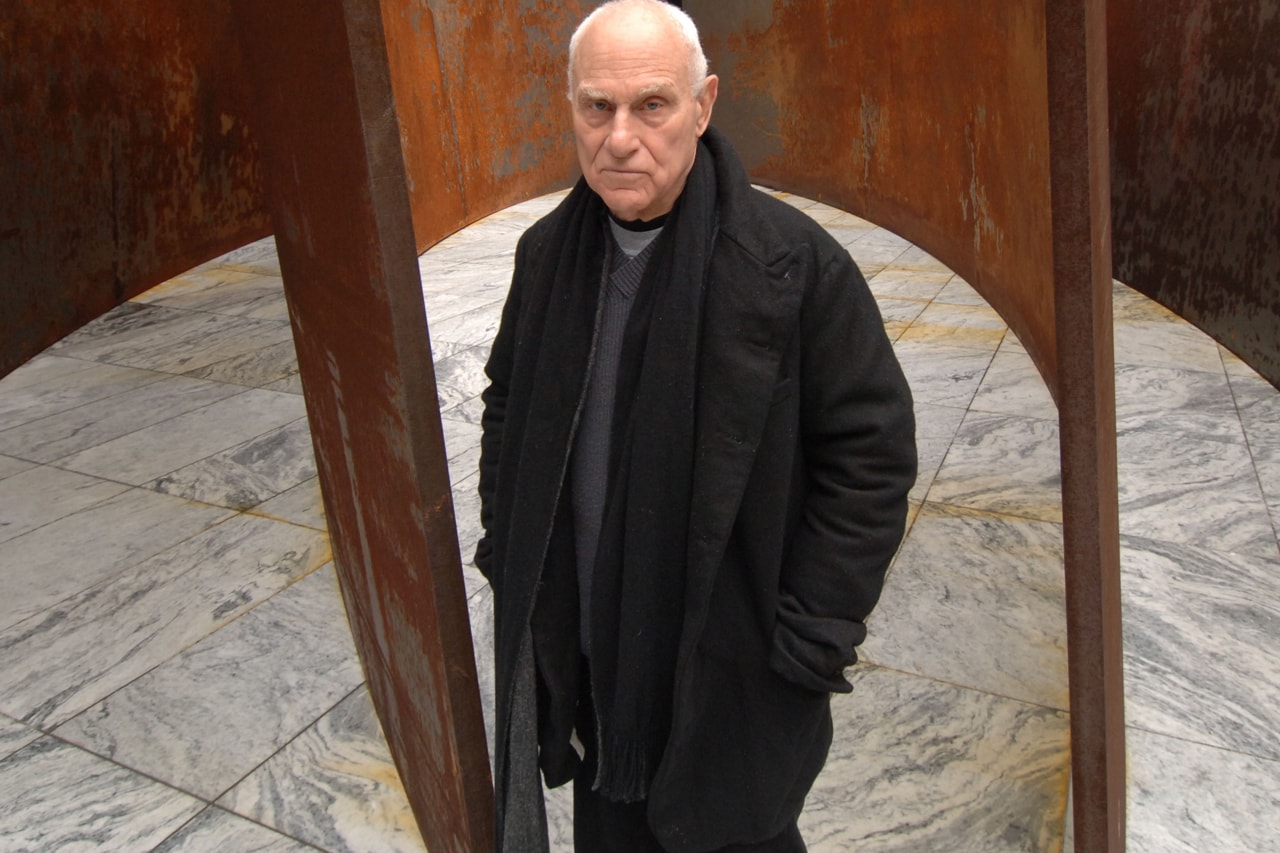Get to know “35 Facts About Richard Serra: How Rich Was American Sculptor?” Richard Serra, born on November 2, 1938, in San Francisco, California, was a renowned American sculptor known for his large-scale abstract steel sculptures. His work was characterized by its substantial presence, forcing viewers to engage with the physical qualities of the works and their particular sites. Serra’s sculptures, while minimalist in nature, evoked a sense of the sublime through their sheer scale and materiality, proposing the idea of sculpture as a phenomenological experience of weight, gravity, space, process, and time.
Serra’s early exposure to metalwork was significant, as his father worked as a pipe fitter in the shipbuilding industry, and Richard himself worked in steel mills during his college years. He attended the University of California, Berkeley, in 1957 and graduated from the university’s Santa Barbara campus in 1961 with a B.A. in English literature. Despite his academic background, Serra’s interest in art led him to study painting at Yale University, where he earned both B.F.A. and M.F.A. degrees by 1964. Supported by fellowships, he spent time in France and Italy before moving to New York City in 1966.

Key Points:
- Richard Serra’s career spanned several decades, marked by his innovative use of steel in large-scale, site-specific sculptures.
- His work has been influential in advancing modern abstract sculpture and has sparked important discussions about the role of art in public spaces.
- Serra’s artistic journey was shaped by early exposure to metalwork and his education in English literature and painting.
- Despite controversy, Serra’s contributions to public art and his influence on other artists and architects have been recognized through numerous awards and honors.
- His work continues to inspire and challenge viewers with its phenomenological experience of weight, gravity, and space.
Who Is Richard Serra?
Serra’s sculptures and drawings were exhibited regularly in Europe and the United States. In 1968, he began a long association with the Leo Castelli Gallery in New York City. His early shows included molten-lead splashings and castings at the meeting of wall and floor. The scale of Serra’s work grew with pieces constructed by techniques such as pinning a sheet of steel to the wall with a rolled lead pipe and leaning steel sheets against each other in configurations held together by gravity alone. In 1970, he began creating large-scale sculptures of rolled steel plates and curved slabs designed for specific sites. Serra’s interest in place and the way an object can shape the space around it made him a popular artist for public art commissions.
Serra moved to New York City in 1966 and later bought a house in Cape Breton, Nova Scotia, where he spent summers working. He married art historian Clara Weyergraf in 1981. As of 2019, Serra maintained homes in Manhattan and studios in Nova Scotia and the North Fork of Long Island. He passed away from pneumonia at his home in Orient, New York, on March 26, 2024, at the age of 85.
Serra’s work was recognized with numerous awards and prizes, including the Fulbright Grant (1965–66), Guggenheim Fellowship (1970), Chevalier de l’Ordre des Arts et des Lettres (1985 and 1991), Tokyo Praemium Imperiale (1994), Leone d’Oro for lifetime achievement at the Venice Biennale (2001), and the National Arts Award: Lifetime Achievement Award (2014), among others.
In addition to his sculptures, Serra began making prints in 1972, developing unconventional printing techniques. His prints, like his sculptures and drawings, reflected an interest in process, scale, and experimentation with material. He produced over 200 printed works, including lithographs and silkscreen prints, which often combined with etching and aquatint.
Serra’s sculptures were not just physical objects but environments to be walked around, into, and through. Inspired by his travels to Japan’s Zen gardens, Serra’s sculptures were phenomenological, unifying human rationality and intellection into moments of lived experience. Some critics argue that Serra’s work breaks up patterns of experience, registering like a break from the lived world, making his work antiphenomenological.
Serra’s work “No Problem,” commissioned by Eli and Edythe Broad and installed at their Oakmont residence in Los Angeles, California, consists of four conical-shaped weatherproof steel plates set in a twisting relationship to each other and the lawn around them. This work, fifteen feet high and weighing a combined sixty tons, reoriented viewers as they walked around and through them, transforming the extravagant weight into a system of experiential balances.
Serra’s influence on the art world was profound, and his work continues to be celebrated for its innovative approach to sculpture, its engagement with the physical and phenomenological aspects of the world, and its enduring impact on the art of the late twentieth and early twenty-first centuries.
Here Are 35 Facts About Richard Serra
- Richard Serra, a prominent contemporary American sculptor, was born on November 2, 1939, in San Francisco.
- Initially, he studied English literature at the University of California, Berkeley, before pursuing art at Yale University under Josef Albers.
- Serra held his first solo exhibition in Rome in 1966, followed by another in Cologne in 1968.
- He was part of a circle of West Coast abstract artists, including Robert Morris, Bruce Nauman, and Keith Sonnier, aiming to expand the perception and potential of various media.
- Two retrospectives of Serra’s sculptures and drawings have been celebrated at the Museum of Modern Art in New York, twenty years apart.
- Known for his large-scale, site-specific sculptures, Serra’s works can be found in architectural, urban, and landscape settings worldwide, from Iceland to New Zealand.
- His sculptures often explore themes of gravity, balance, and power while maintaining a sense of beauty and simplicity.
- Serra seeks to redefine the relationship between art and the viewer by creating spaces that are perceived physically rather than optically.
- Beyond sculpture, Serra has delved into mediums such as drawing, film, video art, and printmaking, exploring unique processes and possibilities in each.
- In the late 1970s and 1980s, his large-scale sculpture commissions sparked controversy due to their stark and unsettling presence.
- Serra has been honored with prestigious awards, including the President’s Medal from the Architectural League of New York and the J. Paul Getty Medal.
- Since 1983, Gagosian has presented over thirty solo exhibitions of Serra’s work in the US and Europe.
- His sculptures often involve weatherproof steel, creating monumental pieces that challenge traditional notions of sculpture.
- Serra’s childhood in San Francisco, where his father worked in shipyards as a pipefitter, inspired his artistic vision.
- Influenced by the launch of an oil tanker on his fourth birthday at the Marine Shipyard, Serra’s earliest artistic influences stemmed from these experiences.
- He began drawing at a young age, nurturing his imagination and artistic potential.
- Serra earned a Bachelor’s degree in English literature from the University of California at Santa Barbara and continued his studies at Yale University, focusing on painting.
- Influenced by artists like Brancusi during his time in Paris and Italy, Serra experimented with grids and random colors in his paintings.
- Repetition, ritual, and obsession are central to Serra’s work, which he views as essential to the creative process.
- He has distanced himself from the heroic status of modernist welded sculpture pioneers like Picasso and Smith by working with Cor-Ten steel.
- Serra’s exploration of video art began in the late 1960s, with his first film, “Hand Catching Lead,” produced in 1968.
- Themes of weight, balance, and the relationship between art and space continue to be prevalent in Serra’s work.
- His sculptures often interact with their surroundings, offering immersive experiences for viewers.
- Serra has exhibited his work in prestigious museums and galleries worldwide, showcasing his innovative approach to sculpture.
- His multidisciplinary practice includes drawing, film, and video art, extending beyond traditional sculpture.
- The use of heavy metals and large-scale installations challenges traditional notions of sculpture and space in Serra’s work.
- Numerous solo exhibitions, retrospectives, and critical acclaim have marked Serra’s career.
- Widely regarded as one of the most influential sculptors of the late 20th century, Serra possesses a forceful personality.
- Despite their monumental scale and weight, Serra’s sculptures often evoke a sense of security and serenity.
- Steel as a material has been a central theme in Serra’s artistic exploration and expression.
- Serra’s work is known for its monumental presence and transformative impact on the spaces it inhabits.
- He has received international recognition for his contributions to contemporary sculpture and art.
- Serra’s sculptures challenge viewers to engage physically with the artwork, emphasizing tactile and spatial aspects.
- His dedication to pushing the boundaries of sculpture and redefining the relationship between art and architecture is evident throughout his career.
- Serra’s innovative approach to sculpture has left a lasting impact on the art world, inspiring new generations of artists and viewers.
Richard Serra: How Rich Was American Sculptor? Career Earning
Richard Serra, the renowned American sculptor, has accumulated substantial wealth throughout his career, predominantly through the sale of his artwork. The financial prosperity Serra has achieved is evident from the remarkable prices his pieces have fetched at auctions over the years. His sculptures have been featured in auctions numerous times, commanding prices ranging from $68 USD to an impressive $4,267,750 USD, depending on factors such as size and medium. Notably, the highest recorded price for a Richard Serra artwork at auction is $4,267,750 USD, achieved by the sale of “L.A. Cone” at Christie’s New York in 2013.

Serra’s artistic journey, defined by his profound affinity for steel as a primary material, has resulted in the creation of monumental steel structures that have captivated audiences globally. His legacy transcends conventional artistic boundaries, ushering in a new era of sculptural innovation. Iconic works like “Tilted Arc,” despite controversy, underscore Serra’s unwavering dedication to pushing artistic frontiers. Throughout his illustrious career, Serra collaborated with esteemed architects and artists, leaving an indelible mark on the architectural landscape.
The financial success of Richard Serra’s career is further exemplified by the substantial prices attained by some of his most valuable artworks at auction. For instance, “LA Cone” fetched $4,267,750, “Schulhof’s Curve” sold for $2,882,500, and “Palms in 2 parts” was acquired for $2,322,500. These elevated prices reflect the esteemed value and demand for Serra’s distinctive and groundbreaking sculptural creations. Moreover, Serra’s foray into prints, films, and videography underscores his versatility and adaptability in the art world.
Richard Serra’s financial achievements and career earnings serve as a testament to his artistic vision, innovative sculptural approach, and enduring influence on the art world. His ability to challenge conventional perceptions of space, form, and materiality through monumental steel sculptures has not only solidified his status as one of the foremost sculptors of his era but has also contributed significantly to his financial prosperity and acclaim within the art market.









